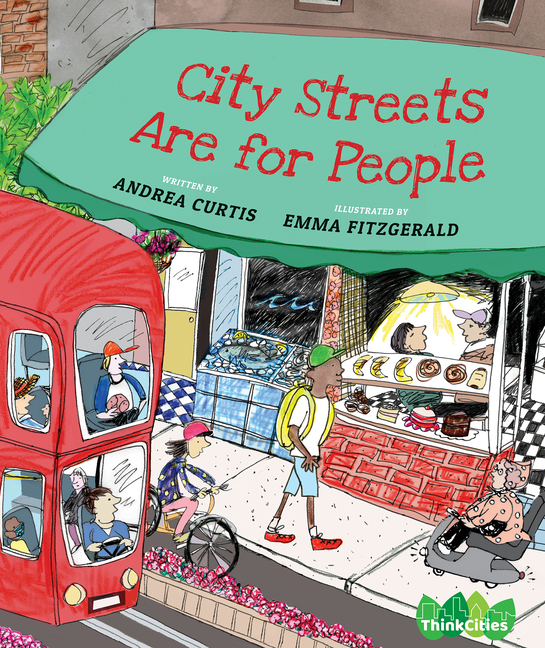Meet-the-Author Recording with Andrea Curtis
City Streets Are for People |
Andrea Curtis introduces and shares some of the backstory for creating City Streets Are for People.
Translate this transcript in the header View this transcript Dark mode on/off
Andrea Curtis: Hi, my name is Andrea Curtis and I'm the author of City Streets Are for People. It's the third book in the ThinkCities series about urban systems and sustainability.
I was inspired to write this book about green transportation because I am a long-time city cyclist. Almost everywhere I go in the city where I live, I get around on my bike. When I was a kid, my parents had a big purple tandem bike, a 'bicycle built for two.' I would bring my friends along for a ride down the street, and it felt like we were in the circus. When I grew up and moved to another city, I still got around on a bicycle. I have friends who remember seeing me was a big pregnant belly, riding my bike down the street when I was carrying my first son. When my boys were little, I rode around with them in a seat behind me. Now I ride beside them or, more likely, behind them because they're very fast.
Sometimes it's wonderful and I feel so free, it's like flying. But sometimes it's scary and noisy and dangerous. There are trucks that come too close for comfort or car drivers that get mad that I'm holding them up. I just try to ride safely and respectfully. I like this city cyclist's motto, "I'm not blocking traffic, I AM traffic." I like that it turns the conventional thinking about bikes and cyclists on its head and makes people look at our city streets in a whole different way.
Of course, I know that not everyone can or wants to ride a bike. So our cities need lots of sustainable transit options that are good for everyone, and for the environment. Street cars and trams, subways and buses, even electric scooters and electric bikes. There are so many ways that we can get around our city safely, and have fun doing it.
I am now going to read from City Streets Are for People.
City streets can be noisy and crowded, dirty, and sometimes even scary. In many cities, cars and trucks rule the road. Sidewalks are narrow or don't exist at all. Kids on foot or riding bicycles and scooters have to dodge and weave, competing with fast moving metal machines. Buses, street cars, and trains can be so jammed, it's hard to move. Transportation is connected to everything we do, from visiting grandma's house or the library, to moving goods and people down the street and around the globe.
In fact, figuring out how to get around with the least possible impact on the planet has turned into one of the biggest challenges of our time. That's because transportation is a huge contributor to our climate crisis. More than 90% of vehicles run on oil and gas known as fossil fuels, which when burned, release carbon dioxide and contribute to global warming. Cars and trucks also spew other types of pollution into the air. This can lead to serious health issues like cancer and heart disease, as well as breathing problems like asthma. Plus, boxing ourselves up inside cars makes us inactive and disconnected from one another.
Traffic accidents are also the leading cause of death for kids and young adults, but it doesn't have to be this way. All over the world, people are reimagining transit and their cities. We're taking over sidewalks to talk and dance, to eat and play. We're making room for bike lanes and electric scooters. We're building green transportation and reclaiming public spaces. City streets are for people.
This Meet-the-Author Recording with Andrea Curtis was exclusively created in August 2022 by TeachingBooks with thanks to House of Anansi Press.




